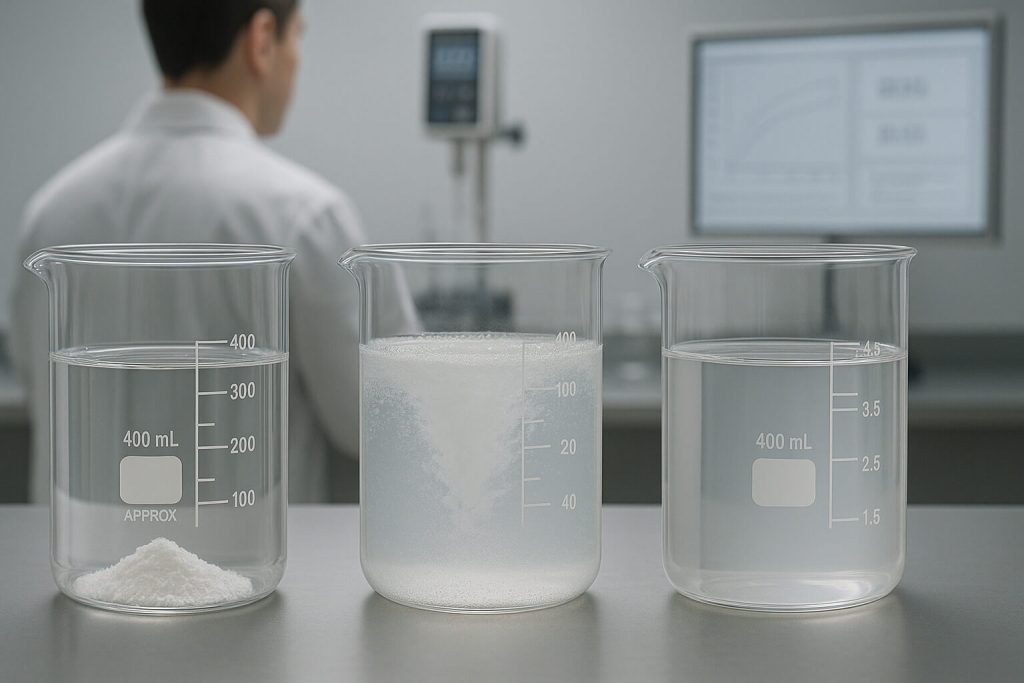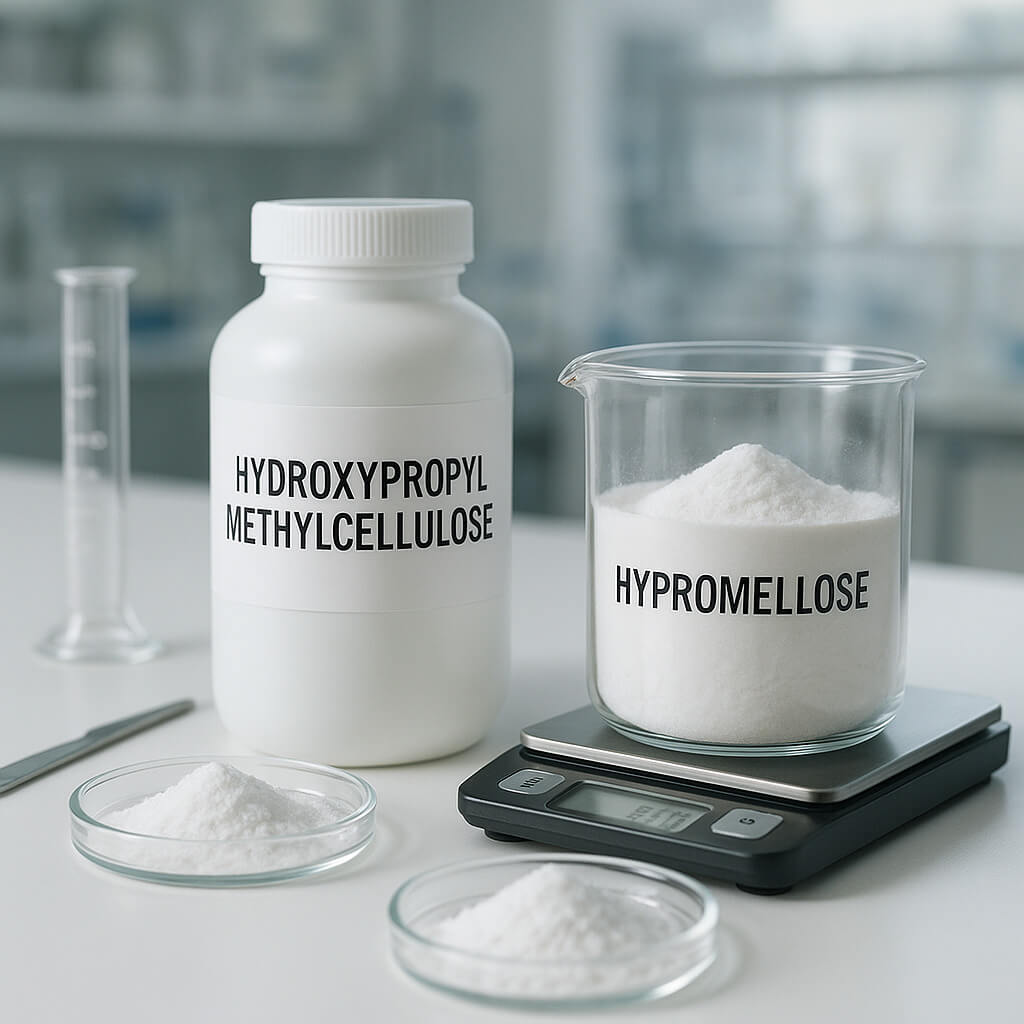Solubility of Methyl Cellulose Products is a critical factor that influences how effectively these substances can be utilized in various industries. The ability of methyl cellulose to dissolve in different solvents affects its application in pharmaceuticals, food production, and cosmetics. Understanding what affects this solubility is essential for manufacturers and formulation scientists alike. This article will explore the key aspects that influence the solubility of methyl cellulose, addressing crucial technical elements that decision-makers in B2B environments need to consider.

1. What Is Methyl Cellulose and Why Is It Used?
Methyl cellulose is a modified form of cellulose, a natural polymer derived from plant cell walls. What’s the real story? This compound is not just a simple thickener; it serves multiple functions that make it valuable across many industries. In pharmaceuticals, it is often used as a binding agent in tablet formulations, ensuring that active ingredients are held together effectively. For food manufacturers, methyl cellulose acts as a gelling agent, stabilizer, or emulsifier, enhancing texture and consistency in products like sauces or gluten-free options.
The importance of methyl cellulose extends beyond functional applications; it’s also non-toxic and generally recognized as safe, making it a favorable choice for formulations intended for human consumption. Its solubility properties are particularly crucial—the ability to dissolve efficiently in various solvents directly influences how well these products perform. For instance, in pharmaceutical applications, optimal solubility can enhance the bioavailability of drugs, leading to better therapeutic outcomes.
Moreover, adapting to trends in consumer preferences—particularly the demand for clean-label products—has made methyl cellulose increasingly relevant. Manufacturers are incorporating it into their formulations to cater to health-conscious consumers, who are now skeptical about synthetic additives. In summary, understanding the versatility and applications of methyl cellulose is foundational for businesses that aim to leverage its properties effectively.
| Applicazione | Importance of Methyl Cellulose |
|---|---|
| Prodotti farmaceutici | Binding agent for tablets and drug formulations |
| Industria alimentare | Thickening and stabilizing agent for consistency |
| Cura della persona | Emulsifier for creams and lotions |
2. What Factors Influence the Solubility of Methyl Cellulose?
Several factors critically influence the solubility of methyl cellulose, and understanding these can significantly impact formulation success. Ready for the good part? First, the polarity of solvents plays a vital role. Methyl cellulose typically dissolves better in polar solvents like water and ethanol. This is due to the hydrophilic hydroxyl groups in its molecular structure that interact favorably with polar molecules, aiding in dissolution.
Temperature also significantly affects solubility. Raising the temperature usually increases the solubility of methyl cellulose, which is a key consideration during manufacturing. For example, heating water can assist in faster dissolution, allowing businesses to save time in production while achieving the desired consistency and performance of their products.
Another critical factor is the pH of the solvent. Methyl cellulose has a varied solubility response to different pH levels. In highly acidic or basic conditions, its molecular structure may shift, affecting its solubility. Therefore, maintaining an optimal pH level is crucial for achieving desirable performance in different applications.
Lastly, the molecular weight of methyl cellulose grades also contributes to solubility variations. Lower molecular weight methyl cellulose grades tend to dissolve more readily compared to higher molecular weight grades, which may be advantageous or detrimental based on the intended application.
By understanding these factors, businesses can optimize their formulations, achieving the desired results more effectively.
| Fattore | Descrizione |
|---|---|
| Polarità del solvente | Higher solubility in polar solvents like water |
| Temperatura | Increased temperatures promote quicker dissolution |
| livelli di pH | Extreme pH can alter methyl cellulose’s solubility |
3. How Does Molecular Weight Affect Methyl Cellulose Solubility?
The molecular weight of methyl cellulose is a crucial determinant of its solubility properties, and this aspect cannot be overstated. But here’s the kicker: Methyl cellulose is available in various grades, each with specific molecular weights that will dramatically affect how it behaves in formulations. Generally, lower molecular weight grades dissolve more quickly in solvents, making them ideal for applications requiring rapid dissolution.
For instance, a low molecular weight methyl cellulose might be used in instant products meant to create gels or solutions quickly, such as in drink mixes or instant soups. In contrast, higher molecular weight grades are often used for applications where a thicker or more viscous solution is desirable. For example, the formulation of a sustained-release pharmaceutical tablet would benefit from a higher molecular weight grade, as it provides a slower, controlled release of the active ingredient.
The implications of molecular weight also extend to application stability. Higher molecular weight methyl cellulose imparts more viscosity to a solution, which can be crucial in both cosmetics and food products to maintain texture and prevent separation. However, it can also present challenges in terms of solubility; these grades may require specific conditions or blends with other agents to ensure they dissolve effectively.
Choosing the appropriate molecular weight for a specific application is fundamental to successfully using methyl cellulose. By carefully considering the desired properties and solubility characteristics, formulators can create highly effective products tailored to meet consumer needs.
| Peso molecolare | Implicazioni applicative |
|---|---|
| Basso peso molecolare | Quick dissolution suitable for rapid applications |
| Peso molecolare medio | Balanced properties for various formulation needs |
| Alto peso molecolare | Increased viscosity for controlled release solutions |
4. What Are the Best Solvents for Dissolving Methyl Cellulose?
Selecting the right solvent for dissolving methyl cellulose can significantly impact the effectiveness of your formulation. What’s the real story? Methyl cellulose can dissolve well in several solvents, each presenting unique properties that may or may not align with the desired application outcome.
Water is undoubtedly the most common solvent used for dissolving methyl cellulose. It allows for efficient dissolution, especially at elevated temperatures. However, water alone does not always yield the optimal result for all grades of methyl cellulose. This is where mixed solvents come into play. Combining water with small amounts of ethanol, for example, can enhance dissolution rates for certain grades while maintaining a suitable viscosity for applications.
In addition to water and ethanol, isopropanol is also a favorable solvent in specific scenarios. It is less polar than water but offers better solubility for certain formulations, particularly in personal care products where a rapid evaporation rate is desirable during application. DMSO (dimethyl sulfoxide) is another solvent option that can dissolve high molecular weight methyl cellulose grades effectively, though it may not be suitable for all applications due to safety and regulatory concerns.
Furthermore, compatibility with the final product should be a priority when selecting a solvent. For instance, in the food industry, avoiding solvents that could leave harmful residues is crucial. By identifying the appropriate solvent, formulators can ensure that their products are not only effective but also safe for consumers to use.
| Tipo di solvente | Proprietà chiave |
|---|---|
| Acqua | Most common and effective for general purposes |
| Etanolo | Enhances dissolution and maintains viscosity |
| Isopropanolo | Rapid evaporation; effective for cosmetics |
5. How Can You Test the Solubility of Methyl Cellulose?
Testing the solubility of methyl cellulose is an essential process for formulators. Are you ready for the good part? Establishing a clear testing protocol allows companies to assess the solubility of different grades effectively.
To start, select various grades of methyl cellulose based on the intended application. This diversified approach offers insight into how each grade behaves in chosen solvents. Prepare a set of test solutions with specific concentrations of methyl cellulose in selected solvents while controlling the temperature and stirring rates to ensure consistent results.
Using a water bath to maintain the temperature throughout the test offers precise control. The agitation speed also impacts solubility; by varying these parameters, you can identify optimal conditions for achieving dissolution.
After the designated testing time, visually inspect the solution’s clarity. If no undissolved particles remain, this typically indicates successful solubility. For a more quantitative assessment, spectrophotometric analysis can gauge the concentration of methyl cellulose in solution, providing concrete data that aids in formulation decisions.
Document each step meticulously. Maintain thorough records that detail the grade of methyl cellulose, the solvent used, and conditions of the test to build a reliable dataset. By conducting systematic solubility testing, formulators can establish benchmarks, troubleshoot issues, and optimize future product developments efficiently.
| Parametro di prova | Approccio consigliato |
|---|---|
| Select Methyl Cellulose Grades | Use various grades for comprehensive evaluation |
| Miscelazione controllata | Maintain consistent stirring and proper temperature |
| Ispezione visiva | Osservare la chiarezza e la presenza di particelle non disciolte |
6. What Are Typical Applications of Methyl Cellulose in Industry?
Methyl cellulose finds versatile applications in various industries, playing a vital role in numerous products. But here’s the kicker: the diverse functionalities of methyl cellulose make it an essential component in pharmaceuticals, food production, and personal care, among others.
In the pharmaceutical field, methyl cellulose is commonly used as a binder or filler in tablet formulations. Its ability to create a cohesive blend promotes uniform distribution of active ingredients and enhances manufacturing efficiency, while also improving bioavailability when ingested.
In the food industry, its thickening properties are utilized in sauces and dressings to provide a smooth texture without compromising flavor. Particularly in gluten-free products, methyl cellulose acts as a substitute for gluten, helping to retain moisture and improve loaf structure.
Additionally, in the cosmetic sector, methyl cellulose serves as an effective emulsifier in creams and lotions. Its gelling properties allow manufacturers to create products with desirable textures that enhance the user experience. For instance, many high-end skin care products leverage methyl cellulose to provide a light, non-greasy feel, making it appealing to consumers.
Overall, the multifunctionality of methyl cellulose ensures its place as a go-to ingredient in various sectors. Understanding how to apply its properties in different contexts allows businesses to enhance product quality and expand their market offerings.
| Industria | Use Cases |
|---|---|
| Prodotti farmaceutici | Binders and fillers in tablets |
| Produzione alimentare | Thickening agent in sauces and gluten-free recipes |
| Cura della persona | Emulsifier for creams and lotions |
7. What Safety Considerations Should Be Noted When Using Methyl Cellulose?
Understanding safety considerations is paramount when working with methyl cellulose in formulations. What’s the key takeaway? While methyl cellulose is generally regarded as safe, proper handling practices must be observed to ensure the safety of workers and consumers alike.
First and foremost, reviewing safety data sheets (SDS) associated with methyl cellulose is essential. These documents provide critical information regarding toxicity and safe handling. Methyl cellulose is typically non-toxic; however, preparation and application processes may involve solvents that require cautious handling due to potential health risks.
Personal Protective Equipment (PPE) plays a crucial role in workplace safety. Wearing gloves, goggles, and masks during handling can mitigate risks associated with dust generation and exposure to solvents. It’s also vital to ensure that well-ventilated settings are maintained during production phases to prevent build-up of fumes, especially when using volatile solvents.
Regular training sessions for employees on the hazards of materials they handle are crucial. This training should cover information from SDS, appropriate usage guidelines, and emergency procedures for accidental exposure or spills.
By prioritizing safety protocols, businesses can not only protect their workers but also ensure that their products are safe for consumer use. Taking these precautions helps mitigate risks and bolsters a company’s reputation as a responsible manufacturer.
| Safety Protocol | Recommended Actions |
|---|---|
| Valutazione della tossicità | Review SDS for handling guidelines |
| Procedure di gestione corrette | Use appropriate PPE and maintain ventilation |
| Formazione del personale | Conduct regular training on safety practices |
8. How Can Understanding Methyl Cellulose Solubility Improve Formulations?
Awareness of the solubility characteristics of methyl cellulose significantly enhances the formulation process. This is where it gets interesting: the solubility of methyl cellulose impacts everything from product stability to consumer satisfaction, making it essential for formulators to grasp these concepts.
Efficient solubility can help ensure that formulations achieve the desired viscosity and texture. In pharmaceuticals, for example, enhancing the dissolution of methyl cellulose contributes to improved product efficacy. A smooth consistency in liquid forms can enhance swallowability for tablets or capsules, leading to better patient compliance.
In the food industry, controlling viscosity and texture linked to methyl cellulose solubility can improve the overall quality and consumer perception of products. Thickness is paramount in food applications; when effectively utilized, methyl cellulose assures customers that they are getting a high-quality product.
Moreover, investing time in understanding these solubility attributes allows formulators to minimize material waste and production time. When methyl cellulose dissolves efficiently, it reduces the likelihood of troubleshooting solubility issues during production. This translates to higher quality outputs that meet customer expectations seamlessly.
Ultimately, the insights gained from understanding methyl cellulose solubility enable companies to create superior products that stand out in the market. By optimizing formulations through strategic usage of methyl cellulose’s solubility traits, businesses can achieve better results and cater to specific consumer needs.
| Improvement Aspect | Impact of Methyl Cellulose Solubility |
|---|---|
| Controllo della viscosità | Raggiunge la consistenza e la consistenza desiderate |
| Efficienza produttiva | Reduces troubleshooting and wasted resources |
| Consumer Quality Perception | Enhances appeal and overall satisfaction |
9. What Current Trends Affect Methyl Cellulose Utilization?
The utilization of methyl cellulose is continuously shaped by emerging trends in various industries. Are you ready for the good part? Recognizing these trends can empower businesses to adapt and maintain a competitive edge.
One of the most significant trends is the increasing consumer demand for clean-label products. Buyers prefer transparency in ingredient sourcing, making methyl cellulose, a non-toxic and natural component, a favorable choice. Companies that prioritize the use of clean and simple ingredients like methyl cellulose can enhance their market appeal and meet consumer expectations.
Sustainability is another pressing issue affecting formulations today. Many manufacturers are seeking eco-friendly practices and sourcing renewable materials. Methyl cellulose, derived from plant cellulose, aligns well with these initiatives and presents an opportunity for businesses to incorporate sustainable elements into their product lines.
Technological innovations are also paving the way for improved formulations. Advancements in rheology modifiers and formulation technologies allow for better control of characteristics like viscosity and solubility. These innovations can significantly enhance product development and improve application performance.
Understanding these current trends enables manufacturers to innovate while aligning their offerings with consumer expectations. By strategically incorporating these insights into their formulations, businesses can position themselves as industry leaders in the evolving landscape.
| Tendenza | Implications for Methyl Cellulose Use |
|---|---|
| Clean-label Demand | Encourages the usage of natural, transparent ingredients |
| Sostenibilità | Promotes eco-friendly formulation practices |
| Innovazioni tecnologiche | Facilitates improved control in formulations |
10. Where Can You Find Reliable Resources on Methyl Cellulose?
Finding reliable resources on methyl cellulose is crucial for professionals navigating the formulation landscape. What’s the real story? By accessing credible information, companies can bolster their understanding and application of methyl cellulose in a way that maximizes efficacy.
A great starting point is the technical literature provided by leading suppliers and manufacturers of methyl cellulose. These documents often include detailed technical data sheets that outline solubility properties, application guidelines, and performance characteristics, which can inform important decision-making.
Industry journals and academic publications are also invaluable resources, offering research articles that delve into methyl cellulose. Journals like the “International Journal of Food Science” and other reputable publications frequently publish findings that can enhance formulators’ knowledge.
Attending industry conferences can further facilitate learning. These gatherings provide opportunities to network, share experiences, and learn from experts about the latest developments in methyl cellulose and its applications.
Being connected to professional organizations in relevant sectors can also yield specialized resources, including technical briefings and ongoing research insights. By leveraging these resources, formulators can improve their understanding of methyl cellulose solubility and enhance product quality and performance.
| Tipo di risorsa | Descrizione |
|---|---|
| Fornitori affidabili | Provide technical resources and documentation |
| Journals and Publications | Offer research articles and valuable insights |
| Conferences and Networking | Facilitate collaboration and knowledge-sharing |
Sezione FAQ
Domanda 1: What is methyl cellulose?
Methyl cellulose is a cellulose derivative that acts as a thickener, stabilizer, and emulsifier in various applications such as pharmaceuticals, food, and personal care products.
D2: How does methyl cellulose solubility work?
Methyl cellulose solubility is influenced by factors such as solvent polarity, temperature, pH levels, and molecular weight, determining its effectiveness in formulation.
D3: What factors influence the solubility of methyl cellulose?
Key factors include the polarity of the solvent, ambient temperature, and the pH level, which affect how well methyl cellulose dissolves in different formulations.
D4: What are the best solvents for dissolving methyl cellulose?
The most effective solvents for dissolving methyl cellulose are water, ethanol, and isopropanol, depending on the specific application and desired performance results.
D5: How can I test the solubility of methyl cellulose?
Testing involves preparing solution batches with controlled variables and observing dissolution rates for clarity and particle presence to assess performance effectively.




